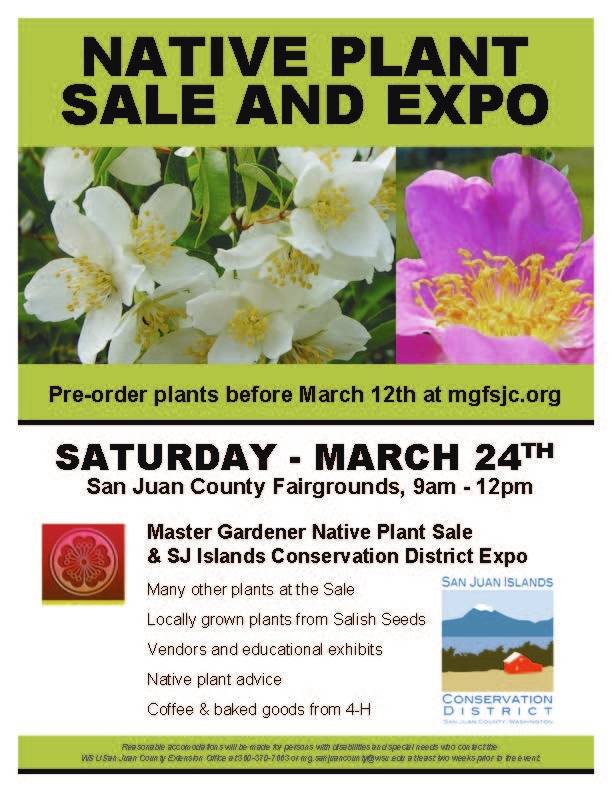Submitted by WSU Master Gardener Foundation of San Juan County
The Washington State University Master Gardener Foundation of San Juan County, in Cooperation with San Juan County WSU Extension, will host its annual Native Plant Sale from 9 a.m. to noon, Saturday, March 24, at the San Juan County Fairgrounds at 849 Argyle Ave.
A variety of potted plants will be available on the day of the event.
Pre-orders can be picked up at the fairgrounds, as well as the Orcas Island Grange and at Sunset Builders, on Lopez from 9 a.m. to noon on March 24.
This year’s selections include 18 species of evergreen and deciduous trees, shrubs and perennials like the ever-popular red flowering currant and blue elderberry.
Natives supply important food sources and shelter for birds, insects and mammals, enhance biodiversity, and require less water once established. This year’s selections include several drought-resistant choices. Sale options include locally grown plants from the San Juan County Land Bank’s Salish Seeds Project, which aims to restore native wildflowers and grasses in the San Juans. Full plant descriptions and cultural requirements are located at www.mgfsjc.org/native-plant-sale-2018.html.
The San Juan Islands Conservation District is also hosting an expo of educational exhibits and vendors at the same time and location as the native plant sale. Members of 4-H will serve coffee and goods. The district is a local partner in stewardship and conservation of natural resources in the San Juan Islands.
The WSU Master Gardener Program is a nationally recognized program that trains volunteers to serve their communities through horticultural education and outreach. Once volunteers receive training, they provide research-based, educational information to the public on vegetable and fruit gardening, native plants, lawn and landscape maintenance, composting, plant problem diagnosis, pest control, and many other concerns. For more information about San Juan County Master Gardeners, visit www.sanjuan.wsu.edu or call 360-378-4414.
Master Gardener Q&A
The Journal sat down with Jane Wentworth, a botanist, Washington State University Extension Master Gardener and coordinator of the Master Gardener Native Plant Sale, to talk shop.
1. How do gardeners benefit from using native plants?
The benefit of native plants…is they are better adapted to our local environment. So once they’re established, they don’t require the same kind of maintenance, [like] fertilizers, over watering, things like that.
2. How does the environment benefit from using native plants?
You’re restoring or expanding what’s already our native plant habitat, which supports wildlife … birds, insects. By using native plants you’re finding plants that are more adaptive and don’t require a lot of chemicals that would often get washed down into our shorelines. They’re [also] a safer bet in terms of invasive plants because our native plants don’t have the same tendency to out-compete and take over like an introduced plant from Europe or Asia might.
3. Is it more important to use native plants on the islands, versus on the mainland?
I think on an island you have to be especially careful … you just have to take care of the limited resources, [but] I’m not sure if it’s more important; I think it’s important anywhere to use native plants. You know, my garden has a combination of native plants and non-native, non-invasive plants … I’m trying to keep kind of a balance of native plants with a nice variety of those plants that are more ornamental and introduced, but not invasive.
4. What are some of your favorite native plants?
The red flowering currant is a really beautiful shrub that attracts hummingbirds when it’s just starting to go into bud and it’ll probably be in flower pretty soon. I like salmonberry a lot as well; that’s a lovely native plant that also has attractive flowers for hummingbirds and other pollinators. In the spring we have an incredible diversity of wildflowers, from the shooting star to camas. I don’t know if you’ve ever been over to Yellow Island, but in the spring it’s pretty spectacular.
5. It seems the islands have more natural yards, as opposed to formal gardens. Do you agree with that? Why do you think that is?
You know, I think it’s kind of a mixed bag. I see a blend of both; the master gardeners I hang out with, and the native plant people I hang out with, we all have pretty natural landscapes for the most part. A garden isn’t really a natural landscape, but it doesn’t need to be a lot of high-maintenance, invasive species either. I don’t think lawns are very sustainable and maybe people are starting to become more aware of that there are lots of other alternatives that are low-maintenance; they don’t always need to be mowed.



